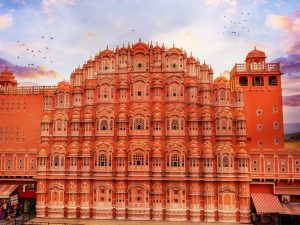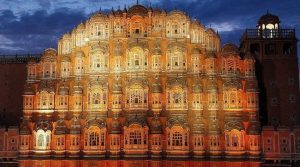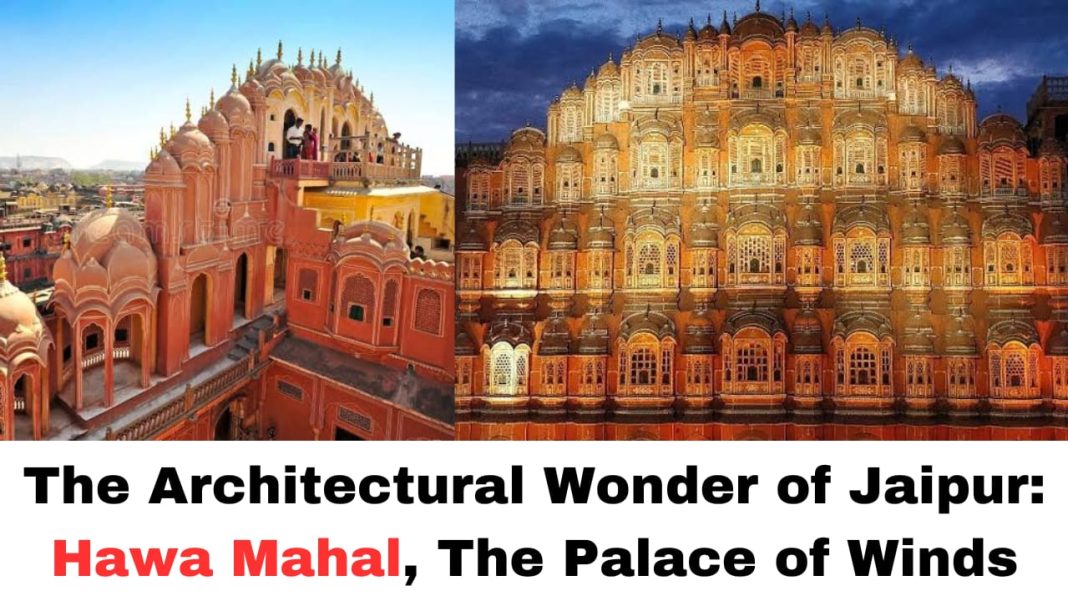Digital News Guru Rajasthan Desk:
The Hawa Mahal, often referred to as the “Palace of Winds,” is one of the most iconic landmarks in Jaipur, Rajasthan, India. Known for its distinctive architecture, intricate detailing, and cultural significance, it stands as a symbol of the grandeur and ingenuity of Rajasthan’s royal history. This architectural marvel attracts millions of tourists every year and continues to be a testament to the fusion of art, culture, and technology.
Historical Background
The Hawa Mahal was built in 1799 by Maharaja Sawai Pratap Singh, a ruler of Jaipur. The palace was constructed primarily as an extension of the Zenana (women’s quarters) of the City Palace. The reason behind its creation was to provide royal women, who adhered to strict purdah (the tradition of seclusion), a way to observe street festivals and royal processions without being seen by the public. The structure’s distinctive windows, with their lattice design, allowed the women to view the happenings on the streets from behind the walls.
The palace was designed by Lal Chand Ustad, a renowned architect of the time. The design is based on the traditional Rajput architectural style with strong Mughal influences. Its unique design, particularly the five-story façade, allowed for ample airflow, which is why it was named “Hawa Mahal”—the “Palace of Winds.”

Architecture and Design
The most striking feature of the Hawa Mahal is its façade, which consists of 953 small windows, known as jharokhas, decorated with intricate latticework. These windows were designed not only for ventilation and aesthetics but also to enable the women of the royal family to remain hidden from the public eye while still enjoying the view of the outside world. The latticework, along with the fact that the palace faces the prevailing winds, helps in creating a cool environment within the building, even in the sweltering heat of Jaipur.
The structure is a blend of Rajput and Mughal architectural styles. It is constructed from pink and red sandstone, which gives it a soft, warm appearance, perfectly matching the color theme of Jaipur, which is known as the “Pink City.” The palace’s overall shape resembles a crown of Lord Krishna, with its delicate windows forming the shape of a honeycomb. The building stands at a height of about 50 feet and is spread across five stories.
One of the most notable aspects of the palace is its pyramid-like shape. The building gradually tapers as it rises, giving it a unique look that is both slender and elegant. The top floors are much smaller than the lower ones, but they retain the same intricate design and architecture. These upper levels are made up of smaller rooms and balconies, providing panoramic views of the city and the surrounding areas.
Cultural and Symbolic Significance
The Hawa Mahal is not just an architectural masterpiece but also a symbol of the royal life and the culture of the time. During the period it was built, royal women had little freedom to interact with the outside world. The lattice windows of Hawa Mahal thus symbolize their restricted yet curious gaze into public life. It was designed to maintain a sense of privacy while allowing the royal women to participate in the cultural and religious events happening in the city.

The palace also played a vital role during the various festivals in Jaipur, such as the famous Teej and Gangaur festivals. These festivals often saw grand processions and celebrations on the streets of Jaipur, and the royal family used the windows of the Hawa Mahal to watch the festivities in full grandeur.
The Structure of Hawa Mahal
The Hawa Mahal is a five-story building that features a central courtyard. Each floor is connected by a set of narrow staircases, with the upper floors offering spectacular views of the city and the surrounding hills. The ground floor of the palace is designed for general public access, while the upper floors were used for the royal family’s residence. Despite its small and seemingly delicate size, the building is structurally strong and durable, a testament to the advanced engineering skills of its creators.
The palace’s interior is equally beautiful, with delicate carvings, arches, and decorative elements that reflect the aesthetic sense of the period. The intricate woodwork, lattice windows, and jharokhas are some of the finest examples of craftsmanship that are still evident in the palace today.
Tourism and Visitor Experience
Today, the Hawa Mahal is one of Jaipur’s most visited tourist attractions. It is part of the UNESCO World Heritage Site of the “Walled City of Jaipur.” Visitors to the palace can explore the various floors, each offering a different view of the city. The upper levels provide an excellent vantage point for photography, especially of the bustling markets and streets below, along with the beautiful architecture of the surrounding buildings.
The museum located within the palace offers a glimpse into the history of the royal family, their lifestyle, and the architecture of the time. Additionally, visitors can enjoy the various cultural exhibitions that are often held in the palace, including art shows, musical performances, and exhibitions on Rajasthani history and culture.

The best time to visit Hawa Mahal is during the early morning or late evening when the weather is cooler, and the light creates a magical glow on the sandstone façade. The palace is open to the public throughout the year, though it tends to get crowded during peak tourist seasons.
Preservation and Challenges
Despite its architectural splendor, the Hawa Mahal faces challenges in terms of preservation. Over the years, the palace has seen signs of wear and tear due to its age and the effects of weather. The Rajasthan government and the Archaeological Survey of India (ASI) have undertaken several restoration projects to preserve the palace’s delicate architecture. These efforts are essential to ensuring that future generations can continue to appreciate the beauty of this historic monument.
Conclusion
Hawa Mahal is a testament to the rich cultural heritage of Jaipur and Rajasthan. Its intricate design, historical significance, and architectural beauty make it a must-visit landmark for anyone exploring the Pink City. From the royal women’s quiet observation of street life to its present status as a symbol of Rajasthan’s royal past, Hawa Mahal continues to captivate visitors with its beauty, mystique, and rich history. As the architectural jewel of Jaipur, it remains a living reminder of the splendor and sophistication of India’s royal era.
You May Also Read: “Nain Matakka” Song Release: A Promising Start for Baby John








